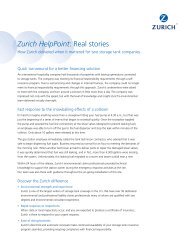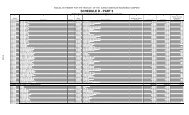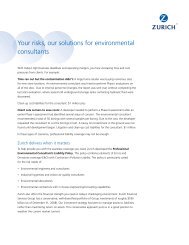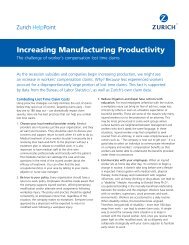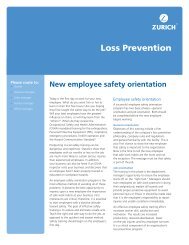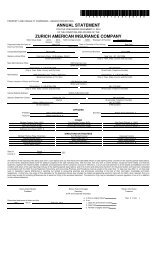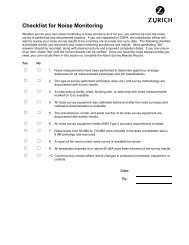Snow and ice removal plans for public places - Zurich
Snow and ice removal plans for public places - Zurich
Snow and ice removal plans for public places - Zurich
You also want an ePaper? Increase the reach of your titles
YUMPU automatically turns print PDFs into web optimized ePapers that Google loves.
• Freezing of water runoff from roof downspouts or gutters<br />
• Puddles <strong>and</strong> refreezing of snow <strong>and</strong> <strong>ice</strong> on walking surfaces<br />
• Icy conditions (black <strong>ice</strong>) on well-traveled paths with foot or vehicular traffic<br />
• Plowing <strong>and</strong> piling of snow causing hazardous conditions, such as visibility obstruction<br />
Management considerations<br />
In order to help mitigate liability risks <strong>for</strong> snow <strong>and</strong> <strong>ice</strong> falls or <strong>for</strong> courtesies to customers <strong>and</strong> visitors to your<br />
premises, business <strong>and</strong> premises owners/managers should have a snow <strong>and</strong> <strong>ice</strong> <strong>removal</strong> plan. This is particularly<br />
important <strong>for</strong> businesses that have customers, invited guests <strong>and</strong> other visitors coming on your premises. <strong>Snow</strong><br />
<strong>removal</strong> is also important <strong>for</strong> reducing employee falls. You may decide to use a contractor <strong>for</strong> snow <strong>removal</strong> or<br />
use in-house resources <strong>and</strong> personnel to accomplish this. If you decide to undertake this task in-house, ensure<br />
that you have adequate personnel, procedures, supplies <strong>and</strong> equipment in place. <strong>Snow</strong> <strong>removal</strong> may be necessary<br />
at early hours be<strong>for</strong>e opening of business <strong>and</strong> several times during the day <strong>and</strong> night. In either case, planning is<br />
essential.<br />
In addition, the plan should include procedures <strong>for</strong> h<strong>and</strong>ling incidents <strong>and</strong> claims, including need <strong>for</strong> immediate<br />
medical assistance <strong>and</strong> claims notification, documentation <strong>and</strong> prompt investigation.<br />
<strong>Snow</strong> <strong>removal</strong> should focus on walkways, parking, entrances <strong>and</strong> other high pedestrian traffic areas. In addition<br />
to snow <strong>removal</strong>, care must be taken to ensure good walking conditions by proper salting <strong>and</strong> to mitigate<br />
slippery conditions from refreezing of snow. Consider using calcium chloride instead of rock salt. Although more<br />
expensive, calcium chloride is more effective at lower temperatures <strong>and</strong> also less harmful to concrete <strong>and</strong><br />
l<strong>and</strong>scaping.<br />
Additional considerations should include:<br />
• Development <strong>and</strong> implementation of a written plan that outlines the responsible person <strong>for</strong> coordination,<br />
contractor selection guidelines, frequency <strong>and</strong> procedures <strong>for</strong> snow <strong>removal</strong>.<br />
• Monitoring of weather in<strong>for</strong>mation <strong>and</strong> recording of pertinent data on snow <strong>removal</strong> log. The log should<br />
include details such as estimated snow accumulation, <strong>ice</strong> build-up, temperature, action taken (e.g. date<br />
<strong>and</strong> time contractor called, plow used, salt applied), inspection notes <strong>and</strong> any unusual conditions.<br />
Fluctuating temperature can lead to refreezing <strong>and</strong> hazardous conditions.<br />
• Posting of warnings in high-hazard areas. Remove or provide warnings of "hidden" hazards that could<br />
be inadvertently struck by cars or pedestrians if covered by snow (fire hydrants, curbs, grates <strong>and</strong> debris<br />
in walkway).<br />
• High piles of snow can also reduce visibility around corners. Melting of snow from piles adjacent to a<br />
walkway can result in refreezing of water on the walkway.<br />
• Consider engineering controls like heated walking surfaces when practical. Relocate downspouts if they<br />
discharge water onto walking surfaces.<br />
• Excessive salt <strong>and</strong> s<strong>and</strong> used in the treatment can be tracked indoors resulting in possible damage to<br />
carpets <strong>and</strong> floor surfaces <strong>and</strong> can even cause a potential slip <strong>and</strong> fall hazard.<br />
Case study<br />
This case involves injuries to a hotel guest in a suburban Minneapolis hotel parking lot. After several inches of<br />
snow fell early on a spring day, it was removed from the parking lot. A couple of days later, after a late night<br />
check-in, a guest fell on <strong>ice</strong> while getting out of the car in the parking lot. The fall resulted in serious injuries<br />
including a fractured leg. Unable to get in the rear entrance, he finally crawled back 200 feet to the car <strong>and</strong><br />
drove to the front of the hotel <strong>for</strong> help. Weather records <strong>for</strong> the day of the accident indicated a high<br />
temperature of 37 º F at 3:00 p.m. <strong>and</strong> the temperature dropping to 28 º F by midnight.<br />
This variation in temperature was sufficient to cause a thaw <strong>and</strong> refreeze in the parking lot area.<br />
The jury found the guest 20 percent liable due to his intoxicated condition. Jurors found the hotel 80 percent<br />
liable, awarding the hotel guest $243,000 <strong>for</strong> his injuries.



